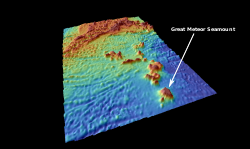| Great Meteor Seamount | |
|---|---|
 Great Meteor Seamount at the southern edge of the Atlantis-Meteor Seamount Complex | |
| Summit depth | 270 m (890 ft) |
| Height | 4,500 m (14,800 ft) |
| Summit area | 50x28 km2 (1465 km2)[1] |
| Location | |
| Location | North Atlantic Ocean, 1,000 km (620 mi) south of the Azores |
| Coordinates | 29°57′10.6″N 28°35′31.3″W / 29.952944°N 28.592028°W |
| Geology | |
| Type | Guyot |
| Volcanic arc/chain | Seewarte Seamounts |
| History | |
| Discovery date | 1938 |
| Discovered by | Meteor |
The Great Meteor Seamount, also called the Great Meteor Tablemount, is a guyot and the largest seamount in the North Atlantic with a volume of 24,000 km3 (5,800 cu mi). It is one of the Seewarte Seamounts, rooted on a large terrace located south of the Azores Plateau. The crust underlying Great Meteor has an age of 85 million years, deduced from the magnetic anomaly 34 (An34) at this location.[2]
The shallow and flat summit of the Great Meteor Seamount, ranging between 150 and 300 m (490 and 980 ft) below sea level, suggests that it may have emerged sometime in the past 30 million years.[3] It is covered by a 150 to 600 m (490 to 1,970 ft) thick layer of limestone, pyroclastic rocks and bioclastic sandstones.[4] Dredged basalts from the top of the eastern and southeastern flanks of the seamount have been K–Ar dated 10.7 ± 0.5 and 16.3 ± 0.4 million years old, respectively.[5] The oldest sample has been 40Ar/39Ar dated at 17 ± 0.3 million years old.[6]
Two small seamounts exist just southwest of Great Meteor and are encircled by the −3800 m bathymetric line. These are the Closs Seamount, roughly oriented NNE-SSW, with its peak at 1,400 m (4,600 ft) depth and covering an area of approximately 390 km2 (150 sq mi), and the Little Meteor Seamount, located NNE of Closs, with over 960 km2 (370 sq mi) and a flat top 400 m (1,300 ft) below sea level.
The German research vessel Meteor discovered the tablemount in 1938. It was given the name Great Meteor Bank, a designation still used in the official GEBCO gazetteer.
- ^ Cite error: The named reference
toswas invoked but never defined (see the help page). - ^ Verhoef, Jaap (1984). "A Geophysical Study of the Atlantis-Meteor Seamount Complex". Geologica Ultraiectina. 38: 1–153. hdl:1874/238521. ISSN 0072-1026.
- ^ Gente, Pascal; Dyment, Jérôme; Maia, Marcia; Goslin, Jean (2003-10-01). "Interaction between the Mid-Atlantic Ridge and the Azores hot spot during the last 85 Myr: Emplacement and rifting of the hot spot-derived plateaus". Geochemistry, Geophysics, Geosystems. 4 (10): 8514. Bibcode:2003GGG.....4.8514G. doi:10.1029/2003gc000527. ISSN 1525-2027. S2CID 56297775.
- ^ Ulrich, von Rad (1974-11-14). "Composition of bioclastic sands, carbonates and pyroclastic rocks of the Great Meteor and Josephine Seamounts, eastern North Atlantic". Pangaea. doi:10.1594/pangaea.548422.
- ^ Wendt, I.; Kreuzer, H.; Müller, P.; Rad, U. von; Raschka, H. (1976). "K-Ar age of basalts from Great Meteor and Josephine seamounts (eastern North Atlantic)". Deep Sea Research and Oceanographic Abstracts. 23 (9): 849–862. Bibcode:1976DSROA..23..849W. doi:10.1016/0011-7471(76)90852-4.
- ^ Geldmacher, Jörg; Hoernle, Kaj; Klügel, Andreas; Bogaard, Paul v. d.; Wombacher, Frank; Berning, Björn (2006-09-01). "Origin and geochemical evolution of the Madeira-Tore Rise (eastern North Atlantic)". Journal of Geophysical Research: Solid Earth. 111 (B9): B09206. Bibcode:2006JGRB..111.9206G. doi:10.1029/2005jb003931. ISSN 2156-2202.